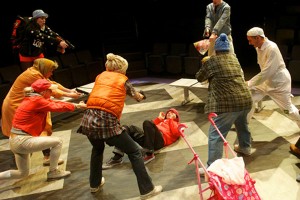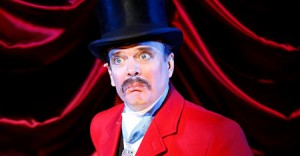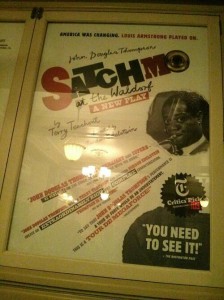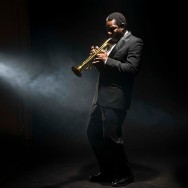 “Words realize nothing, vivify nothing to you, unless you have suffered in your own person the thing which the words try to describe.”
“Words realize nothing, vivify nothing to you, unless you have suffered in your own person the thing which the words try to describe.”
Mark Twain, A Connecticut Yankee in King Arthur’s Court
Terry Teachout on the arts in New York City
In today’s Wall Street Journal I review Ayckbourn Ensemble, a triple bill of Alan Ayckbourn plays currently running off Broadway. Here’s an excerpt.
* * *
Ever since Alan Ayckbourn’s “Private Fears in Public Places” came to New York in 2005, 59E59 Theaters’ annual “Brits Off Broadway” festival has made Mr. Ayckbourn’s work a reasonably regular part of its bill of fare. Now the festival is presenting three of his plays in rotating repertory under the portmanteau title of “Ayckbourn Ensemble,” all of them directed by the playwright himself and performed by his own company, Scarborough’s Stephen Joseph Theatre. Two of the plays, “Arrivals & Departures” and “Farcicals,” are world premieres and the third, “Time of My Life,” is being seen in New York for the first time. That makes “Ayckbourn Ensemble” a major event by definition, since Mr. Ayckbourn, whom many critics on both sides of the Atlantic long dismissed as a prolific purveyor of flyweight farces, is now increasingly recognized as a playwright of real stature, one of the very best we have.
 Mr. Ayckbourn’s genius lies in his ability to write what you might call “sad comedies,” uproariously funny farce-flavored plays that are at second glance deeply serious, at times despairing portraits of modern middle-class life and its discontents. On occasion, as in “Arrivals & Departures,” he puts the despair at center stage, and what results is a play that at bottom can no longer be called a comedy at all. The scene is a London train platform where a preposterously ineffectual trap is being laid for a terrorist. Enter a sullen young woman (Elizabeth Boag) and an amiable old duffer (Kim Wall) whose minds are elsewhere, and to whose vagrant memories the members of the audience are privy. As the dragnet tightens, we learn about the piercing sorrows of their little lives, and what began as a comedy of incompetent bureaucracy becomes a tragedy that ends in shocking blackness….
Mr. Ayckbourn’s genius lies in his ability to write what you might call “sad comedies,” uproariously funny farce-flavored plays that are at second glance deeply serious, at times despairing portraits of modern middle-class life and its discontents. On occasion, as in “Arrivals & Departures,” he puts the despair at center stage, and what results is a play that at bottom can no longer be called a comedy at all. The scene is a London train platform where a preposterously ineffectual trap is being laid for a terrorist. Enter a sullen young woman (Elizabeth Boag) and an amiable old duffer (Kim Wall) whose minds are elsewhere, and to whose vagrant memories the members of the audience are privy. As the dragnet tightens, we learn about the piercing sorrows of their little lives, and what began as a comedy of incompetent bureaucracy becomes a tragedy that ends in shocking blackness….
Even when the tone of an Ayckbourn play is unabashedly frothy, seriousness is never very far from the surface. “Farcicals,” for instance, is a double bill of brilliantly concise one-act farces about two suburban couples (played by Ms. Boag, Bill Champion, Sarah Stanley and Mr. Wall) whose marriages are frayed around the edges. The laughter is near-continuous, especially in “Chloë With Love,” in which Ms. Stanley plays a demoralized frump who dresses up as a sex-crazed vamp in order to excite her wayward spouse. But Mr. Ayckbourn never lets you forget that both marriages really are in trouble—and that it’s the men, as usual in his woman-centric plays, who deserve the bulk of the blame….
* * *
Read the whole thing here.
The trailer for Arrivals & Departures:
Here’s my list of recommended Broadway, off-Broadway, and out-of-town shows, updated weekly. In all cases, I gave these shows favorable reviews (if sometimes qualifiedly so) in The Wall Street Journal when they opened. For more information, click on the title.
BROADWAY:
• Bullets Over Broadway (musical, PG-13, reviewed here)
• Cabaret (musical, PG-13/R, nearly all performances sold out last week, closes Jan. 4, reviewed here)
• The Cripple of Inishmaan (serious comedy, PG-13, reviewed here)
 • A Gentleman’s Guide to Love & Murder (musical, PG-13, all performances sold out last week, reviewed here)
• A Gentleman’s Guide to Love & Murder (musical, PG-13, all performances sold out last week, reviewed here)
• Matilda (musical, G, most performances sold out last week, reviewed here)
• Les Misérables (musical, G, too long and complicated for young children, many performances sold out last week, reviewed here)
• Of Mice and Men (drama, PG-13, nearly all performances sold out last week, reviewed here)
• Once (musical, G/PG-13, reviewed here)
• A Raisin in the Sun (drama, G/PG-13, all performances sold out last week, reviewed here)
• Rocky (musical, G/PG-13, reviewed here)
OFF BROADWAY:
• The Fantasticks (musical, G, suitable for children capable of enjoying a love story, reviewed here)
IN CHICAGO:
• Juno (musical, PG-13, closes July 27, reviewed here)
IN GLENCOE, ILL.:
• The Dance of Death (drama, PG-13, closes Aug. 3, reviewed here)
• Days Like Today (musical, PG-13, closes July 13, reviewed here)
CLOSING SOON OFF BROADWAY:
• Casa Valentina (drama, PG-13, closes June 29, reviewed here)
CLOSING NEXT WEEK IN EAST HADDAM, CONN.:
• Damn Yankees (musical, G, closes June 21, reviewed here)
CLOSING SUNDAY IN CAMBRIDGE, MASS.:
• The Tempest (Shakespeare, G, closes June 15, reviewed here)
CLOSING SUNDAY ON BROADWAY:
• Act One (drama, G, too long for children, reviewed here)
I went to see the off-Broadway production of Satchmo at the Waldorf last Friday for the first time in a month. I’m going back again next week. I expect I’ll see it two or three more times before the final performance on June 29—and that I’ll enjoy it just as much each time.
Paul Hindemith, the least pretentious artist who ever lived, would doubtless have laughed himself silly at the very thought of a playwright going to see his own show over and over again. According to the mezzo-soprano Jennie Tourel:
Hindemith, after he wrote a piece, wasn’t interested in it anymore. He never came to hear my Marienleben; although he knew I do it very well, he said he’s not interested to hear it—he’s written it.
Bernard Herrmann claimed that Alfred Hitchcock felt the same way about his films:
He runs them for people but he always leaves the room. When it says “The End” he comes back with a cigar. He says, “Why do I want to see it? I see all the things that are wrong with it. There’s nothing I can do now.”
Not me. I only got to see The Letter, my first operatic collaboration with Paul Moravec, performed three times by the Santa Fe Opera in 2009. I felt that I had to get back to my day job as a drama critic not long after The Letter opened, and I’ve regretted ever since not having taken another couple of weeks off and seeing it two or three more times.
 But…why? What’s the point of seeing a show of your own repeatedly, unless you’re there to give notes to the cast and crew after the performance (which in my case scarcely ever happens) or planning to revise the script (which I don’t intend to do with Satchmo)? What do you get out of going back to see a play that you already know better than anyone else?
But…why? What’s the point of seeing a show of your own repeatedly, unless you’re there to give notes to the cast and crew after the performance (which in my case scarcely ever happens) or planning to revise the script (which I don’t intend to do with Satchmo)? What do you get out of going back to see a play that you already know better than anyone else?
I won’t deny that part of the pleasure that I take in watching Satchmo at the Waldorf is simple pride of ownership. I made this! I sometimes say to myself when the house lights go down and John Douglas Thompson walks out on stage. It’s an exhilarating sensation, one completely unlike seeing a book that you wrote in a store or on a shelf, and it doesn’t get old, at least not for me.
But this sensation, gratifying though it is, doesn’t last for very long. What I now find most interesting about seeing Satchmo, by contrast, is the way in which John’s performance, and the audience’s response to it, change from night to night. He and I talked about this process, among other things, when Marc Myers interviewed us for The Wall Street Journal last week:
“At a critical moment toward the end of the play, Armstrong shrugs off an unfortunate event and says he’ll include it in his autobiography,” said Mr. Thompson. “When we started rehearsals, I said the line as ‘I guess I’ll have to put that in the book, too,’ almost as an afterthought. Then I took out ‘have to,’ so it was more direct and emotional: ‘I guess I’ll put that in the book, too.’ It’s a self-realization that the event is an inescapable part of his legacy. Now the line is, ‘Guess…I’ll put that…in the book…too.’ It’s a bit slower and weighted, and resigned to what he must do.”
The interview appears in today’s Journal, and you can read the whole thing here. If you’re interested in how actors, writers, and directors work together to bring a play to the stage—and how they respond to the “input” of live audiences—you might want to take a look.
 Satchmo at the Waldorf is nearing the end of its off-Broadway run at the Westside Theatre. The final performance will be on Sunday, June 29, at three p.m.
Satchmo at the Waldorf is nearing the end of its off-Broadway run at the Westside Theatre. The final performance will be on Sunday, June 29, at three p.m.
If you’re counting, that adds up to a four-month New York run—18 previews and 136 performances. Not too shabby for a novice playwright who never expected his first play to be performed anywhere, much less in Orlando, Lenox, New Haven, Philadelphia, and New York. I’m infinitely grateful to John Douglas Thompson, Gordon Edelstein, and my other wonder-working colleagues who made it possible.
I should add that we’ve had numerous inquiries from other cities, and that we expect the play to be performed elsewhere in due course. According to the press release announcing the closing, “Future productions are planned for San Francisco, Chicago and London.” I’ll say no more for the moment, but…watch this space.
In the meantime, go here to order tickets for the remainder of the New York run. Don’t wait—time is short!
 A rare film clip of Charles Laughton as Bottom in an abridged TV version of Peter Hall’s stage production of A Midsummer Night’s Dream, filmed at Stratford-upon-Avon in 1959. After the clip, Hall talks to Simon Callow about Laughton’s acting:
A rare film clip of Charles Laughton as Bottom in an abridged TV version of Peter Hall’s stage production of A Midsummer Night’s Dream, filmed at Stratford-upon-Avon in 1959. After the clip, Hall talks to Simon Callow about Laughton’s acting:
(This is the latest in a series of arts-related videos that appear in this space each Monday and Wednesday.)
An ArtsJournal Blog